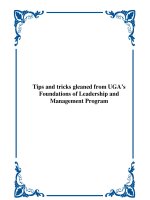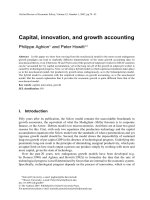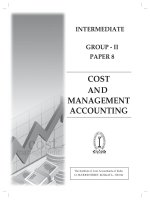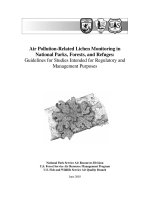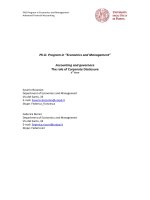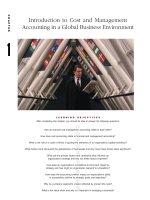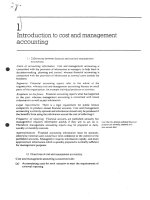FINANCIAL AND MANAGEMENT ACCOUNTING doc
Bạn đang xem bản rút gọn của tài liệu. Xem và tải ngay bản đầy đủ của tài liệu tại đây (10.92 MB, 820 trang )
Pauline
Weetman
Financial and
Management
Accounting
Financial and Management
Accounting
Fourth Edition
Fourth
Edition
ISBN 0-273-70369-2
9 780273 703693
Additional student support at
www.pearsoned.co.uk/weetman
www.pearson-books.com
This revised and fully updated edition continues to provide students with a clear and well-structured
introduction to financial and management accounting. It retains all of the classic features that have
contributed to the book’s success: clarity of expression, the focus on the accounting equation, stu-
dent activities and real-life commentaries running through each chapter, and the inclusion of the Safe
and Sure Annual Report as a real world example of a listed company.
New to the fourth edition:
■ Fully in line with IFRS, but provides comparative analysis with UK GAAP where relevant.
■ New case study material including extracts from annual reports for companies such as The Body
Shop, Sainsbury's, British Airports Authority, Matalan, Argos, Homebase, Burberry, Ottakers,
Carphone Warehouse and BP.
■ Experience-driven conversations between two managers appear at intervals throughout the text,
providing a valuable insight into the type of interpretative comment which the reader may find
more taxing. These discussions allow a more candid examination of issues and problems within
the subject.
■ Fully redesigned text to aid navigation and understanding for students, including a unique colour-
coding system to make technical material more accessible.
■ Activity-based costing, strategic management accounting, the balanced scorecard and bench-
marking are included in the main management accounting chapters.
■ The approach to teaching and learning focuses on subject-specific knowledge outcomes and
generic skills outcomes, with end-of-chapter self-evaluation.
■ Questions are graded to test student understanding of chapter content, as well as skills in
straightforward application of knowledge, and skills of problem solving and evaluation.
Financial and Management Accounting: An Introduction is aimed at first-level undergraduates on
business studies degrees taking introductory financial accounting and management accounting
classes; first-level specialist accounting undergraduate students; introductory core accounting for
MBA and postgraduate specialist Masters students (e.g. finance, actuarial studies), focusing on
analysis through the accounting equation and a questioning approach to problem solving; and
professional courses where accounting is introduced for the first time.
The book is accompanied by a comprehensive support package for lecturers, arranged on a
chapter-by-chapter basis and comprising the following: student lecture notes on a ‘fill the gaps’
basis; matching PowerPoint slides; graded questions to supplement those in chapters, including
multiple choice questions; and solutions to questions in the book.
The author
Pauline Weetman BA, BSc (Econ), PhD, CA, FRSE, is Professor of Accounting at the University of
Strathclyde, and has extensive experience of teaching at undergraduate and postgraduate level, with
previous chairs held at Stirling and Heriot-Watt Universities. She received the Distinguished Academic
Award of the British Accounting Association in 2005. She has convened the examining board of the
Institute of Chartered Accountants of Scotland and was formerly Director of Research at ICAS.
an imprint of
Cover image © Superstock
An Introduction
An Introduction
Pauline Weetman
0273703692.qxd 18/4/06 10:53 Page 1
FINANCIAL AND
MANAGEMENT ACCOUNTING
An Introduction
Visit the Financial and Management Accounting: An Introduction,
fourth edition Companion Website at www.pearsoned.co.uk/weetman
to find valuable student learning material including:
l Multiple choice questions to test your learning
l Extensive links to valuable resources on the web
l An online glossary to explain key terms
FAM_A01.qxd 12/4/06 13:37 Page i
We work with leading authors to develop the strongest
educational materials in business and finance, bringing
cutting-edge thinking and best learning practice to a
global market.
Under a range of well-known imprints, including
Financial Times Prentice Hall, we craft high quality print
and electronic publications which help readers to
understand and apply their content, whether studying
or at work.
To find out more about the complete range of our
publishing, please visit us on the World Wide Web at:
www.pearsoned.co.uk
FAM_A01.qxd 12/4/06 13:37 Page ii
Fourth Edition
FINANCIAL AND
MANAGEMENT ACCOUNTING
An Introduction
Pauline Weetman
Professor of Accounting
University of Strathclyde
FAM_A01.qxd 12/4/06 13:37 Page iii
To my parents,
Harry and Freda Weetman
Pearson Education Limited
Edinburgh Gate
Harlow
Essex CM20 2JE
England
and Associated Companies throughout the world
Visit us on the World Wide Web at:
www.pearsoned.co.uk
First edition published under the
Financial Times Pitman Publishing imprint in 1996
Second edition published in 1999
Third edition published in 2003
Fourth edition published in 2006
© Pearson Education Limited 1996, 1999, 2003, 2006
The right of Pauline Weetman to be identified as author of this work
has been asserted by her in accordance with the Copyright, Designs
and Patents Act 1988.
All rights reserved. No part of this publication may be reproduced, stored
in a retrieval system, or transmitted in any form or by any means, electronic,
mechanical, photocopying, recording or otherwise, without either the prior
written permission of the publisher or a licence permitting restricted copying
in the United Kingdom issued by the Copyright Licensing Agency Ltd,
90 Tottenham Court Road, London W1T 4LP.
ISBN-13: 978-0-273-70369-3
ISBN-10: 0-273-70369-2
British Library Cataloguing-in-Publication Data
A catalogue record for this book is available from the British Library
Library of Congress Cataloging-in-Publication Data
A catalog record for this book is available from the Library of Congress
10987654321
10 09 08 07 06
Typeset in 9.5/12pt Palatino by 35
Printed and bound by Mateu Cromo, Madrid, Spain
FAM_A01.qxd 12/4/06 13:37 Page iv
Preface to the fourth edition
xx
Guided tour of the book xxvi
FINANCIAL ACCOUNTING
Part 1 A conceptual framework: setting the scene 3
1 Who needs accounting? 4
2 A systematic approach to financial reporting:
the accounting equation
26
3 Financial statements from the accounting equation 50
4 Ensuring the quality of financial statements
73
Part 2 Reporting the transactions of a business 101
5 Accounting information for service businesses 102
6 Accounting information for trading businesses 131
Part 3 Recognition in financial statements 157
7 Published financial statements 158
8 Non-current (fixed) assets
196
9 Current assets 234
10 Current liabilities 263
11 Provisions and non-current (long-term) liabilities 282
12 Ownership interest
304
Part 4 Analysis and issues in reporting 333
13 Ratio analysis 334
14 Reporting corporate performance 361
15 Reporting cash flows 393
MANAGEMENT ACCOUNTING
Part 5 Setting the scene and defining the basic tools of
management accounting
421
16 Functions of management accounting 422
17 Classification of costs 447
18 Product costs: materials, labour and overheads
469
Contents in brief
FAM_A01.qxd 12/4/06 13:37 Page v
Contents in briefvi
Part 6 Product costs and stock valuation 505
19 Job costing
506
Part 7 Decision making 529
20 Breakeven analysis and short-term decision making 530
Part 8 Planning and control 559
21 Preparing a budget 560
22 Standard costs
598
23 Performance evaluation and feedback reporting
628
Part 9 Capital investment appraisal and business strategy 651
24 Capital investment appraisal 652
25 Business strategy and management accounting
682
Financial accounting terms defined G1
Management accounting terms defined
G11
Appendices
I Information extracted from annual report of Safe and
Sure plc, used throughout Financial Accounting
A1
II Solutions to numerical and technical questions in
Financial Accounting
A15
III Solutions to numerical and technical questions in
Management Accounting
A39
Index I1
FAM_A01.qxd 12/4/06 13:37 Page vi
Preface to the fourth edition xx
Guided tour of the book xxvi
Publisher’s acknowledgements xxviii
FINANCIAL ACCOUNTING
Part 1 A conceptual framework: setting the scene
Chapter 1 Who needs accounting? 4
Real World Case 4
Learning outcomes 5
1.1 Introduction
5
1.2 The development of a conceptual framework 7
1.3 Framework for the preparation and presentation of
financial statements
8
1.4 Types of business entity 8
1.5 Users and their information needs 12
1.6 General purpose or specific purpose financial statements?
17
1.7 Stewards and agents 17
1.8 Who needs financial statements? 18
1.9 Summary 19
Further reading 20
Questions 20
A Test your understanding 20
B Application 21
C Problem solving and evaluation 21
Activities for study groups 22
Notes and references 22
Supplement: Introduction to the terminology of business transactions 24
Test your understanding 25
Chapter 2 A systematic approach to financial reporting:
the accounting equation
26
Real World Case 26
Learning outcomes 27
2.1 Introduction 28
2.2 The accounting equation 28
Contents
FAM_A01.qxd 12/4/06 13:37 Page vii
Contentsviii
2.3 Defining assets 29
2.4 Examples of assets 31
2.5 Recognition of assets
33
2.6 Defining liabilities 35
2.7 Examples of liabilities 36
2.8 Recognition of liabilities 37
2.9 Defining the ownership interest
39
2.10 Recognition
39
2.11 Changes in the ownership interest 39
2.12 Assurance for users of financial statements
41
2.13 Summary
42
Further reading 44
Questions 44
A Test your understanding 44
B Application 45
C Problem solving and evaluation 45
Activities for study groups 46
Notes and references 46
Supplement: Debit and credit bookkeeping 47
Test your understanding 49
Chapter 3 Financial statements from the accounting equation 50
Real World Case 50
Learning outcomes 51
3.1 Introduction 51
3.2 Who is in charge of the accounting rules? 52
3.3 The accounting period
52
3.4 The balance sheet 53
3.5 The income statement (profit and loss account) 57
3.6 The cash flow statement 59
3.7 Usefulness of financial statements 62
3.8 Summary 63
Questions 63
A Test your understanding 63
B Application 64
Activities for study groups 65
Supplement: Using the accounting equation to analyse transactions 66
Test your understanding 72
Chapter 4 Ensuring the quality of financial statements 73
Real World Case 73
Learning outcomes 74
4.1 Introduction 75
4.2 Qualitative characteristics of financial statements 75
4.3 Measurement in financial statements 79
4.4 Views on prudence 82
FAM_A01.qxd 12/4/06 13:37 Page viii
Contents ix
4.5 Regulation of financial reporting 84
4.6 Reviewing published financial statements 92
4.7 Summary
97
Further reading 98
Questions 98
A Test your understanding 98
B Application 99
C Problem solving and evaluation 99
Activities for study groups 100
Notes and references 100
Part 2 Reporting the transactions of a business
Chapter 5 Accounting information for service businesses 102
Real World Case 102
Learning outcomes 103
5.1 Introduction 103
5.2 Analysing transactions using the accounting equation 104
5.3 Illustration of accounting for a service business
107
5.4 A process for summarising the transactions: a spreadsheet
111
5.5 Financial statements as a means of communication 113
5.6 Summary 116
Questions 116
A Test your understanding 116
B Application 117
Supplement: Recording transactions in ledger accounts –
a service business 118
Test your understanding 130
Chapter 6 Accounting information for trading businesses 131
Real World Case 131
Learning outcomes 132
6.1 Introduction 133
6.2 Goods purchased for resale 133
6.3 Manufacturing goods for resale 135
6.4 Illustration of accounting for a trading business 138
6.5 A process for summarising the transactions: a spreadsheet 142
6.6 Financial statements of M. Carter, wholesaler 144
6.7 Summary
146
Questions 147
A Test your understanding 147
B Application 148
Supplement: Recording transactions in ledger accounts:
a trading business 149
Test your understanding 156
FAM_A01.qxd 12/4/06 13:37 Page ix
Contentsx
Part 3 Recognition in financial statements
Chapter 7 Published financial statements 158
Real World Case 158
Learning outcomes 160
7.1 Introduction
160
7.2 International influences
161
7.3 Accounting framework 162
7.4 Balance sheet
166
7.5 Income statement (profit and loss account)
171
7.6 Cash flow statement 173
7.7 Group structure of companies 177
7.8 Group financial statements 179
7.9 Beyond the annual report
182
7.10 Summary 186
Further reading 187
Useful websites 187
Questions 187
A Test your understanding 187
B Application 189
C Problem solving and evaluation 189
Activities for study groups 189
Notes and references 190
Supplement 7.1: Information to be presented on the face of the
Balance Sheet, as required by IAS 1 191
Supplement 7.2: Balance sheet format 1, as prescribed by the
Companies Act 1985 192
Supplement 7.3: Information to be presented on the face of the
Income Statement as required by IAS 1 194
Supplement 7.4: UK Companies Act: Profit and loss account
format 1 – list of contents 195
Chapter 8 Non-current (fixed) assets 196
Real World Case 196
Learning outcomes 197
8.1 Introduction 198
8.2 Definitions 198
8.3 Recognition
200
8.4 Users’ needs for information 202
8.5 Information provided in the financial statements 203
8.6 Usefulness of published information 205
8.7 Depreciation: an explanation of its nature 206
8.8 Reporting non-current (fixed) assets and depreciation in
financial statements 211
8.9 Summary 219
FAM_A01.qxd 12/4/06 13:37 Page x
Contents xi
Further reading 220
Questions 220
A Test your understanding 220
B Application 221
C Problem solving and evaluation 221
Activities for study groups 222
Notes and references 223
Supplement: Recording non-current (fixed) assets and depreciation 224
Test your understanding 233
Chapter 9 Current assets 234
Real World Case 234
Learning outcomes 236
9.1 Introduction 236
9.2 Definitions 236
9.3 The working capital cycle
237
9.4 Recognition 238
9.5 Users’ needs for information 241
9.6 Information provided in the financial statements
242
9.7 Measurement and recording
244
9.8 Inventories (stocks) of raw materials and finished goods 245
9.9 Receivables (debtors) 249
9.10 Prepayments
251
9.11 Revenue recognition 252
9.12 Summary 254
Questions 254
A Test your understanding 255
B Application 255
C Problem solving and evaluation 256
Activities for study groups 257
Notes and references 257
Supplement: Bookkeeping entries for (a) bad and doubtful debts;
and (b) prepayments 258
Test your understanding 262
Chapter 10 Current liabilities 263
Real World Case 263
Learning outcomes 264
10.1 Introduction 264
10.2 Definitions
265
10.3 Recognition 266
10.4 Users’ needs for information 267
10.5 Information provided in the financial statements 268
10.6 Measurement and recording 269
10.7 Accruals and the matching concept 271
10.8 Liabilities for taxation 274
10.9 Summary 275
FAM_A01.qxd 12/4/06 13:37 Page xi
Contentsxii
Questions 276
A Test your understanding 276
B Application 276
C Problem solving and evaluation 277
Activities for study groups 277
Notes and references 278
Supplement: Bookkeeping entries for accruals 279
Test your understanding 281
Chapter 11 Provisions and non-current (long-term) liabilities 282
Real World Case 282
Learning outcomes 283
11.1 Introduction 284
11.2 Users’ needs for information 285
11.3 Information provided in the financial statements
285
11.4 Provisions 288
11.5 Deferred income 291
11.6 Non-current (long-term) liabilities
292
11.7 Summary 298
Questions 299
A Test your understanding 299
B Application 299
C Problem solving and evaluation 300
Activities for study groups 301
Notes and references 301
Supplement: Bookkeeping entries for provisions and deferred income 302
Test your understanding 303
Chapter 12 Ownership interest 304
Real World Case 304
Learning outcomes 305
12.1 Introduction 306
12.2 Definition and recognition 306
12.3 Presentation of ownership interest 307
12.4 Additional primary financial statements 314
12.5 Users’ needs for information 315
12.6 Information provided in the financial statements 315
12.7 Dividends 319
12.8 Issue of further shares on the Stock Exchange 320
12.9 Summary 323
Questions 324
A Test your understanding 324
B Application 324
C Problem solving and evaluation 325
Activities for study groups 327
Notes and references 327
Supplement: A spreadsheet for adjustment to a trial balance
at the end of the accounting period 328
Test your understanding 332
FAM_A01.qxd 12/4/06 13:37 Page xii
Contents xiii
Part 4 Analysis and issues in reporting
Chapter 13 Ratio analysis 334
Real World Case 334
Learning outcomes 335
13.1 Introduction
335
13.2 A note on terminology
336
13.3 Systematic approach to ratio analysis 336
13.4 Investors’ views on risk and return
343
13.5 Pyramid of ratios
346
13.6 Use and limitations of ratio analysis 347
13.7 Worked example of ratio analysis 348
13.8 Linking ratios to the cash flow statement 354
13.9 Summary
357
Questions 357
A Test your understanding 358
B Application 358
C Problem solving and evaluation 360
Chapter 14 Reporting corporate performance 361
Real World Case 361
Learning outcomes 363
14.1 Introduction 363
14.2 Operating and Financial Review (OFR) 363
14.3 Other guidance in analysis
367
14.4 Segmental information 371
14.5 Off-balance sheet finance 376
14.6 Corporate social responsibility
377
14.7 Corporate governance 380
14.8 Developing issues: ‘Present fairly’ and ‘true and fair view’ 381
14.9 Measurement of value 384
14.10 Developing issues: How valid is the stakeholder model 387
14.11 Summary 387
Questions 389
A Test your understanding 389
B Application 390
C Problem solving and evaluation 390
Activities for study groups 390
Notes and references 391
Chapter 15 Reporting cash flows 393
Real World Case 393
Learning outcomes 394
15.1 Introduction 394
15.2 Cash and cash equivalents 395
15.3 The direct method and the indirect method 395
15.4 Preparing a cash flow statement: the indirect method 399
15.5 Preparing a cash flow statement: the direct method 407
FAM_A01.qxd 12/4/06 13:37 Page xiii
Contentsxiv
15.6 Interpretation of cash flow information 408
15.7 Illustration 408
15.8 Summary
413
Further reading 413
Questions 413
A Test your understanding 414
B Application 414
C Problem solving and evaluation 415
Notes and references 417
MANAGEMENT ACCOUNTING
Part 5 Setting the scene and defining the basic tools of
management accounting
Chapter 16 Functions of management accounting 422
Real World Case 422
Learning outcomes 423
16.1 Introduction 424
16.2 Meeting the needs of internal users
426
16.3 Management functions
427
16.4 Role of management accounting 432
16.5 Judgements and decisions: case study illustrations 435
16.6 The language of management accounting
440
16.7 Summary 441
Further reading 441
Questions 441
A Test your understanding 441
B Application 442
C Problem solving and evaluation 443
Cases for study groups 446
Notes and references 446
Chapter 17 Classification of costs 447
Real World Case 447
Learning outcomes 448
17.1 Definition of a cost 448
17.2 The need for cost classification 449
17.3 The meaning of ‘activity’ and ‘output’ 449
17.4 Variable costs and fixed costs 450
17.5 Direct costs and indirect costs 454
17.6 Product costs and period costs
456
17.7 Cost classification for planning, decision making and control 458
17.8 Cost coding 461
17.9 Cost selection and reporting 462
17.10 Summary 463
Further reading 464
FAM_A01.qxd 12/4/06 13:37 Page xiv
Contents xv
Questions 464
A Test your understanding 464
B Application 465
C Problem solving and evaluation 467
Cases for study groups 467
Chapter 18 Product costs: materials, labour and overheads 469
Real World Case 469
Learning outcomes 470
18.1 Introduction
471
18.2 Accounting for materials costs 472
18.3 Accounting for labour costs
476
18.4 Production overheads: traditional approach 478
18.5 Activity-based costing (ABC) for production overheads
488
18.6 Comparing traditional approach and ABC 496
18.7 Summary 498
Further reading 499
Questions 499
A Test your understanding 499
B Application 500
C Problem solving and evaluation 502
Cases for study groups 503
Notes and references 503
Part 6 Job costs and stock valuation
Chapter 19 Job costing 506
Real World Case 506
Learning outcomes 507
19.1 Introduction 507
19.2 Job cost records: an illustration 509
19.3 Job costing: applying the accounting equation to transactions 512
19.4 Absorption costing and marginal costing 517
19.5 Moving forward 521
19.6 Summary 522
Questions 523
A Test your understanding 524
B Application 524
C Problem solving and evaluation 526
Cases for study groups 527
Part 7 Decision making
Chapter 20 Breakeven analysis and short-term decision making 530
Real World Case 530
Learning outcomes 531
FAM_A01.qxd 12/4/06 13:37 Page xv
Contentsxvi
20.1 Introduction 532
20.2 Cost behaviour: fixed and variable costs 532
20.3 Breakeven analysis
537
20.4 Using breakeven analysis 540
20.5 Limitations of breakeven analysis 543
20.6 Applications of cost-volume-profit analysis 543
20.7 Cases in short-term decision making
545
20.8 Pricing decisions
550
20.9 Summary 552
Questions 553
A Test your understanding 553
B Application 554
C Problem solving and evaluation 555
Cases for study groups 556
Part 8 Planning and control
Chapter 21 Preparing a budget 560
Real World Case 560
Learning outcomes 561
21.1 Introduction
562
21.2 Purpose and nature of a budget system 562
21.3 Administration of the budgetary process 565
21.4 The benefits of budgeting
569
21.5 Behavioural aspects of budgeting 572
21.6 Approaches to budgeting 575
21.7 Practical example – development of a budget
577
21.8 Shorter budget periods 587
21.9 Summary 590
Questions 591
A Test your understanding 591
B Application 592
C Problem solving and evaluation 594
Cases for study groups 597
Chapter 22 Standard costs 598
Real World Case 598
Learning outcomes 599
22.1 Introduction 600
22.2 Purpose of using standard costs 600
22.3 The level of output to be used in setting standards
601
22.4 The control process 602
22.5 Direct materials cost variance 603
22.6 Direct labour cost variance 605
22.7 Variable overhead cost variance 606
22.8 Fixed overhead expenditure variance 607
22.9 Case study: Allerdale Ltd 607
FAM_A01.qxd 12/4/06 13:37 Page xvi
Contents xvii
22.10 Investigating variances 612
22.11 Flexible budgets and variance analysis 613
22.12 Case study: Brackendale Ltd
614
22.13 Is variance analysis, based on standard costs, a useful exercise? 618
22.14 A broader view of applications of variance analysis 619
22.15 Summary 620
Questions 620
A Test your understanding 621
B Application 621
C Problem solving and evaluation 624
Cases for study groups 626
Notes and references 627
Chapter 23 Performance evaluation and feedback reporting 628
Real World Case 628
Learning outcomes 629
23.1 Introduction
629
23.2 Preparing performance reports 631
23.3 Performance evaluation 632
23.4 Benchmarking
637
23.5 Non-financial performance measures
638
23.6 The balanced scorecard 640
23.7 Management use of performance measurement 642
23.8 Summary
644
Further reading 645
Questions 645
A Test your understanding 645
B Application 646
C Problem solving and evaluation 646
Cases for study groups 649
Part 9 Capital investment appraisal and business strategy
Chapter 24 Capital investment appraisal 652
Real World Case 652
Learning outcomes 653
24.1 Purpose of capital investment appraisal 654
24.2 Payback method 656
24.3 Accounting rate of return 658
24.4 Net present value method 660
24.5 Internal rate of return 665
24.6 Mutually exclusive projects 668
24.7 Which methods are used in practice?
670
24.8 Control of investment projects: authorisation and review 671
24.9 Advanced manufacturing technologies 672
24.10 Summary 673
Further reading 674
FAM_A01.qxd 12/4/06 13:37 Page xvii
Contentsxviii
Questions 674
A Test your understanding 674
B Application 675
C Problem solving and evaluation 676
Cases for study groups 679
Supplement: Table of discount factors 680
Chapter 25 Business strategy and management accounting 682
Real World Case 682
Learning outcomes 683
25.1 Introduction
683
25.2 Strategic management accounting 684
25.3 The just-in-time approach 685
25.4 Value chain analysis 686
25.5 Total quality management and cost of quality
687
25.6 Business process re-engineering 688
25.7 E-business and e-commerce 689
25.8 Summary
692
Further reading 692
Questions 693
A Test your understanding 693
B Application 693
C Problem solving and evaluation 694
Cases for study groups 694
Note and reference 694
Financial accounting terms defined G1
Management accounting terms defined G11
Appendices
I Information extracted from annual report of Safe and
Sure Group plc, used throughout Financial Accounting A1
II Solutions to numerical and technical questions in
Financial Accounting A15
III Solutions to numerical and technical questions in
Management Accounting A39
Index I1
FAM_A01.qxd 12/4/06 13:37 Page xviii
Supporting resources
Visit www.pearsoned.co.uk/weetman to find valuable online resources.
Companion Website for students
l Multiple choice questions to test your learning
l Extensive links to valuable resources on the web
l An online glossary to explain key terms
For instructors
l Student handouts containing a skeleton outline of each chapter
l PowerPoint slides that can be downloaded and used as OHTs
l Suggested discussion answers to real world case studies
l Solutions to questions in the text
l Additional multiple choice questions and further graded questions in application of
knowledge and in problem solving
Also, the Companion Website provides the following features:
l Search tool to help locate specific items of content
l E-mail results and profile tools to send results of quizzes to instructors
l Online help and support to assist with website usage and troubleshooting
For more information please contact your local Pearson Education sales representative or
visit
www.pearsoned.co.uk/weetman.
FAM_A01.qxd 12/4/06 13:37 Page xix
Introduction
The implementation of International Financial Reporting Standards (IFRS) in the
UK from January 2005 marked the start of an intensely interesting and challenging
period for those involved in preparing or using the annual reports and financial
statements of listed UK companies. It also brought a challenge for those involved in
accounting education, namely how to ensure that our students understand and can
apply the approach represented in IFRS while still being aware that many organisa-
tions in the UK will continue to follow the UK tradition as set out in company law
and UK accounting standards. For listed companies, in their group accounts, IFRS
are mandatory. For all other companies the use of IFRS is a matter of choice with the
alternative being to cling to the UK tradition. For unincorporated businesses and for
the public sector the prospect of IFRS-related practice is probably still some way into
the future.
This book takes up the challenge by using the international framework as its primary
focus. This enables students in their early stages of study to understand and analyse
the published annual reports and financial statements of our largest businesses.
However it also explains the UK tradition, where this differs from the IFRS, so that
students will also understand and appreciate small business accounts or financial
statements of public sector entities and not-for-profit organisations.
The book is written for the first level of undergraduate degree study in accounting
and business studies, or equivalent introductory accounting courses for any profes-
sional training where an understanding of accounting is a basic requirement. The fourth
edition is thoroughly revised to reflect International Financial Reporting Standards.
A new chapter on the interpretation and presentation of cash flow statements has been
added in response to requests. The underlying pedagogy of previous editions has
been retained in response to encouraging comments from reviewers and from users
of the book.
As institutions come under increasing scrutiny for the quality of the teaching and
learning experience offered, a textbook must do more than present the knowledge and
skills of the chosen subject. It must make explicit to the students what targets are to be
achieved and it must help them to assess realistically their own achievements of those
targets. It must help the class lecturer prepare, deliver, explain and assess the know-
ledge and skills expected for the relevant level of study. This is achieved by stating
learning outcomes at the start of each chapter and by ensuring that the chapter head-
ings and the end-of-chapter questions address the stated outcomes.
The management accounting chapters continue the approach of previous editions
in taking some of the newer costing techniques into mainstream discussion, reflecting
their increasing acceptance in management accounting practice. Business strategy and
competitive position are recurring themes.
An accompanying website at www.pearsoned.co.uk/weetman provides the
lecturer with a complete resource pack for each chapter. Student handouts containing
a skeleton outline of each chapter, leaving slots for students to complete; overhead-
projector masters that match the lecture handouts, additional multiple-choice questions
Preface to the fourth edition
FAM_A01.qxd 12/4/06 13:37 Page xx
Preface to the fourth edition xxi
and further graded questions in application of knowledge and in problem solving; all
are new features for this fourth edition.
End-of-chapter questions are graded according to the skills being assessed. There
are tests of retained knowledge, tests of application of knowledge in straightforward
situations and tests of problem solving and evaluation using the acquired knowledge
in less familiar situations.
Overall the aim of the fourth edition is to provide an introduction to financial
accounting which engages the interest of students and encourages a desire for further
study. It also contributes to developing the generic skills of application, problem
solving, evaluation and communication, all emphasised by employers.
Subject coverage
Financial reporting is an essential component in the process of communication
between a business and its stakeholders. The importance of communication increases
as organisations become larger and more complex. Reporting financial information
to external stakeholders not involved in the day-to-day management of the business
requires a carefully balanced process of extracting the key features while preserving
the essential core of information. The participants in the communication process
cover a wide range of expertise and educational background, so far as accounting is
concerned. The range begins with those who prepare financial statements, who may
have a special training in accounting techniques, but it ends with those who may
be professional investors, private investors, investment advisers, bankers, employee
representatives, customers, suppliers and journalists.
One very significant group of stakeholders in any business is the internal management
of the organisation. Managers have access to a wealth of detailed financial information
and a responsibility for the careful management of the assets and operations of the
organisation. The way in which the managers of an organisation use financial informa-
tion is very much contingent on the purpose for which the information is intended.
Management accounting is a specialist area of study within accounting more gener-
ally. Ideally, management accounting and financial accounting would coalesce if the
external users could be given access to all internal information, but that might damage
the competitive position of the business and would probably swamp the external
users in detail.
First-level degree courses in accounting are increasingly addressed to this broad
base of potential interest and this book seeks to provide such a broad base of under-
standing while also supplying a sound technical base for those intending to pursue
specialised study of the subject further. In particular it makes use of the Framework for
the Preparation and Presentation of Financial Statements which is used by the Interna-
tional Accounting Standards Board in developing and reviewing accounting standards.
That Framework is intended to help preparers, users and auditors of financial state-
ments to understand better the general nature and function of information reported in
financial statements.
Aim of the book
The fourth edition has been updated throughout. It aims to provide a full understand-
ing of the key aspects of the annual report, concentrating in particular on companies
in the private sector but presenting principles of wider application which are relevant
also to organisations operating in the public sector.
In the management accounting section, the book aims to establish a firm under-
standing of the basic techniques, while recognising that more recent developments in
management accounting are becoming widespread. A contingency approach is adopted
which emphasises that the selection of management accounting techniques is conditional
FAM_A01.qxd 12/4/06 13:37 Page xxi
Preface to the fourth editionxxii
on management’s purpose. To meet this purpose, the management accountant performs
the roles of directing attention, keeping the score and solving problems. Strategic man-
agement accounting is emphasised from the outset so that students are aware that
management accounting must take an outward-looking approach. These themes are
reiterated throughout, concluding with an explanation of the role of management
accounting in business strategy, particularly e-business in the new economy. A student
who has completed this first-level study of management accounting will be aware
of many of the day-to-day practices of management accounting in business and the
relevance of those practices. It also provides a self-contained, broad introduction to
management accounting for business students who do not need to develop specialist
knowledge.
In particular
An international perspective reflects the convergence in accounting standards across the
European Union for listed companies. Features specific to the UK are retained where
these continue to be relevant to other enterprises.
Concepts of financial accounting are identified by applying the principles enunciated
by the Interational Accounting Standards Board in its Framework for the Preparation
and Presentation of Financial Statements. The Framework emphasises the desirability
of meeting the needs of users of financial statements and it takes a balance sheet-
oriented approach. That approach is applied consistently throughout the book, with
some indication of the problems which may arise when it is clear that the established
emphasis on the matching of revenues and costs may give a more rational explanation
of existing practice.
User needs are explained in every chapter and illustrated by including first-person
commentary from a professional fund manager, holding a conversation with an audit
manager. The conversations are based on the author’s research in the area of com-
munication through the annual report.
The accounting equation is used throughout the financial accounting section for
analysis and processing of transactions. It is possible for students who do not seek
a technical specialism to complete the text without any reference to debit and credit
bookkeeping. It is, however, recognised that particular groups of students may wish
to understand the basic aspects of debit and credit bookkeeping and for this purpose
the end-of-chapter supplements revisit, on a debit and credit recording basis, material
already explored in the chapter. Debit and credit aspects of management accounting
are not covered since these are regarded as best reserved for later specialist courses
if the student so chooses.
Practical illustration is achieved by drawing on the financial information of a fictiti-
ous major listed company, taking an overview in early chapters and then developing
the detailed disclosures as more specific matters are explored.
Interpretation of financial statements is a feature of all financial reporting chapters,
formally brought together in Chapters 13 and 14. The importance of the wider range
of corporate communication is reinforced in Chapter 14. This chapter also includes a
discussion of some current developments that are under debate in the context of inter-
national convergence.
A running example of the fictitious company Safe and Sure plc provides illustra-
tion and interpretation throughout the chapters. Safe and Sure plc is in the service
sector. The website contains a parallel example, Craigielaw plc, in the manufacturing
sector. On the website there are questions on Craigielaw to accompany most of the
chapters.
Self-evaluation is encouraged by setting learning outcomes at the start of each chapter
and reviewing these in the chapter summaries. Activity questions are placed at various
stages throughout each chapter. Self-testing questions at the end of the chapter may
be answered by referring again to the text. Further end-of-chapter questions provide a
FAM_A01.qxd 12/4/06 13:37 Page xxii
Preface to the fourth edition xxiii
range of practical applications. Group activities are suggested at the end of each chapter
with the particular aim of encouraging participation and interaction. Answers are avail-
able to all computational questions, either at the end of the book or on the website.
A sense of achievement is engendered in the reader of the financial accounting section
by providing a general understanding of the entire annual report by the end of
Chapter 7. Thereafter specific aspects of the annual report are explored in Chap-
ters 8–12. Lecturers who wish to truncate a first-level course or leave specific aspects
to a later level will find Chapters 8–12 may be used on a selective basis.
A spreadsheet approach to financial accounting transactions is used in the body of the
relevant chapters to show processing of transactions using the accounting equation.
The author is firmly convinced, after years of trying every conceivable approach, that
the spreadsheet encourages students to apply the accounting equation analytically,
rather than trying to memorise T-account entries. Furthermore students now use spread-
sheets as a tool of analysis on a regular basis and will have little difficulty in applying
suitable software in preparing spreadsheets. In the bookkeeping supplementary sections,
the three-column ledger account has been adopted in the knowledge that school
teaching is moving increasingly to adopt this approach which cuts out much of the
bewilderment of balancing T-accounts. Computerised accounting systems also favour
the three-column presentation with continuous updating of the balance.
Flexible course design
There was once a time when the academic year comprised three terms and we all knew
the length of a typical course unit over those three terms. Now there are semesters,
trimesters, modules and half-modules so that planning a course of study becomes an
exercise in critical path analysis. This text is written for one academic year comprising
two semesters of 12 weeks each but may need selective guidance to students for a
module of lesser duration.
In financial accounting, Chapters 1–4 provide an essential conceptual framework
which sets the scene. For a general appreciation course, Chapters 5 and 6 are practical
so that one or both could be omitted, leading directly to Chapter 7 as a guide to
published accounts. Chapters 8–12 are structured so that the explanation of prin-
ciples is contained early in each chapter, but the practical implementation is later in
each chapter. For a general appreciation course, it would be particularly important to
refer to the section of each chapter which analyses users’ needs for information and
discusses information provided in the financial statements. However, the practical
sections of these chapters could be omitted or used on a selective basis rather than
attempting full coverage. Chapters 13 and 14 are important to all readers for a sense
of interpretation and awareness of the range of material within corporate reports.
Chapter 15 takes the reader through a cash flow statement item-by-item with the
emphasis on understanding and interpretation.
In teaching and learning management accounting various combinations are possible,
depending on course design and aims. Chapters 16, 17 and 18 provide an essential set
of basic tools of analysis but thereafter some flexibility is feasible. For applications
in job costing, Chapter 19 provides further material. For concentrating on decision
making and awareness of business strategy, Chapters 20, 24 and 25 are recommended.
For concentrating on planning and control, Chapters 21, 22 and 23 give students
experience of the variety of techniques in use.
Approaches to teaching and learning
Learning outcomes
Targets for student achievement in relation to knowledge and understanding of the
subject are specified in learning outcomes at the head of each chapter. The achievements
FAM_A01.qxd 12/4/06 13:37 Page xxiii
Preface to the fourth editionxxiv
represented by these learning outcomes are confirmed against graded questions at the
end of each chapter. The achievement of some learning outcomes may be confirmed
by Activities set out at the appropriate stage within the chapter.
Skills outcomes
The end-of-chapter questions test not only subject-specific knowledge and technical
skills but also the broader general skills that are transferable to subsequent employ-
ment or further training.
Graded questions
End-of-chapter questions are graded and each is matched to one or more learning
outcomes. Where a solution is provided to a question this is shown by an [S] after the
question number.
A series questions: Test your understanding
The A series questions confirm the application of technical skills. These are skills
specific to the subject of accounting which add to the specialist expertise of the student.
More generally they show the student’s capacity to acquire and apply a technical skill
of this type.
The answers to these questions can be found in relevant sections of the chapter, as
indicated at the end of each question.
B series questions: Application
The B series questions apply the knowledge gained from reading and practising
the material of the chapter. They resemble closely in style and content the technical
material of the chapter. Confidence is gained in applying knowledge in a situation that
is very similar to that illustrated. Answers are given in Appendix II or on the website.
These questions test skills of problem-solving and evaluation that are relevant to
many subjects and many activities in life, especially in subsequent employment. Some
initiative is required in deciding how to apply relevant knowledge and in solving
problems.
C series questions: problem solving and evaluation
The C series questions apply the knowledge gained from reading the chapter, but in
a varied style of question. Problem-solving skills are required in selecting relevant
data or in using knowledge to work out what further effort is needed to solve the
problem. Evaluation means giving an opinion or explanation of the results of the
problem-solving exercise. Some answers are given in Appendix II but others are on
the website so that they can be used in tutorial preparation or class work.
Group and individual cases
Cases apply knowledge gained from the chapter but they also test communication
skills. Communication may involve writing or speaking, or both. It may require, for
example, explanation of a technical matter to a non-technical person, or discussion
with other students to explore a controversial issue, or presentation of a report to a
business audience.
S series questions in supplementary sections
The S series questions test knowledge of the accounting records system (bookkeeping
entries) to confirm understanding by those who have chosen to study the supplementary
bookkeeping sections.
FAM_A01.qxd 12/4/06 13:37 Page xxiv


